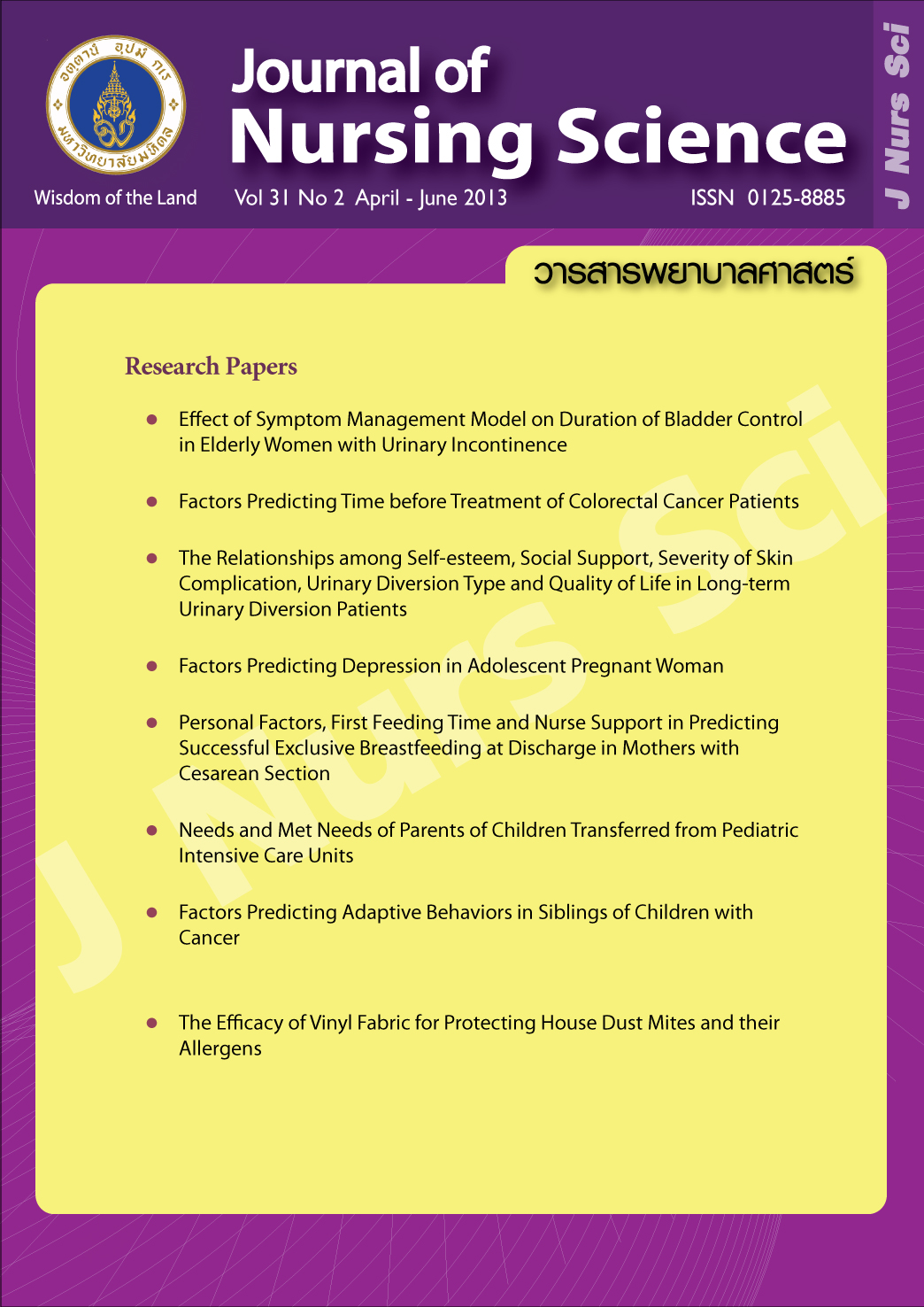Factors Predicting Depression in Adolescent Pregnant Woman
Main Article Content
Abstract
Purpose: To determine the factors predicting depression in adolescent pregnant woman.
Design: A correlational predictive design.
Methods: The sample were composed of 145 first-time pregnant women aged between 10-19 who attended antenatal clinic at Siriraj Hospital. Data were collected using demographic data form, Rosenberg’s self-esteem Scale, the Short–Form Locked Marital Adjustment Questionnaire, the Multidimensional Scale of Perceived Social Support, and the Center for Epidemiologic Study-
Depression Scale. Results were analyzed using descriptive statistics, point biserial correlation, Pearson’s correlation and multiple regression.
Main findings: The results showed that 20.6% of the adolescent pregnant women experienced depression. There was a negative correlation between self-esteem (r = - .533, p < .01), marital adjustment (r = - .433, p < .01), social support (r = - .242, p < .01), type of family (rpb = - .21, p < .01), family income (r = - .170, p < .05) and depression. Results of multiple regression analysis indicated that self-esteem (β = - .401, p < .001) marital adjustment (β = - .255, p < .01), and type of family (β = - .165, p < .05) could significantly predict depression. All 13 factors could explain 40% of the variance in the depression.
Conclusion and recommendations: The findings suggest that nurses should screening depression in adolescent pregnant women and should develop nursing interventions or programs to reduce depression, promote self-esteem, and marital adjustment. Establishment of adolescent pregnant clinic for those who lack support from parents and relatives is essential.
ปัจจัยทำนายภาวะซึมเศร้าในสตรีตั้งครรภ์วัยรุ่น
รุ่งทิพย์ กาศักดิ์, เยาวลักษณ์ เสรีเสถียร, อารีรัตน์ บางพิเชษฐ์
บทคัดย่อ
วัตถุประสงค์: เพื่อศึกษาปัจจัยทำนายภาวะซึมเศร้าในสตรีตั้งครรภ์วัยรุ่น
รูปแบบการวิจัย: การวิจัยครั้งนี้เป็นการวิจัยศึกษาความสัมพันธ์เชิงทำนาย
วิธีดำเนินการวิจัย: กลุ่มตัวอย่างเป็นสตรีตั้งครรภ์วัยรุ่นครรภ์แรก อายุระหว่าง 10-19 ปีที่มารับบริการฝากครรภ์ที่หน่วยฝากครรภ์โรงพยาบาลศิริราช จำนวน 145 ราย เก็บรวบรวมข้อมูลโดยใช้แบบสอบถามข้อมูลส่วนบุคคล แบบสอบถามความรู้สึกมีคุณค่าในตนเอง แบบสอบถามการปรับตัวในชีวิตสมรส แบบสอบถามการรับรู้การสนับสนุนทางสังคม และแบบคัดกรองภาวะซึมเศร้า (CES-D) วิเคราะห์ข้อมูลโดยใช้สถิติเชิงบรรยาย สถิติสัมประสิทธิ์สหสัมพันธ์แบบพ้อยท์ไบซีเรียล สถิติสัมประสิทธิ์สหสัมพันธ์ของเพียร์สัน และสถิติถดถอยพหุคูณ
ผลการวิจัย: ร้อยละ 20.6 ของกลุ่มตัวอย่างมีภาวะซึมเศร้าในระยะตั้งครรภ์ ความรู้สึกมีคุณค่าในตนเอง (r = - .533, p < .01) การปรับตัวในชีวิตสมรส (r = - .433, p < .01) การรับรู้การสนับสนุนทางสังคม (r = - .242, p < .01) ลักษณะครอบครัว (rpb = - .214, p < .01) และรายได้ครอบครัว (r = - .170, p < .05) มีความสัมพันธ์ทางลบกับภาวะซึมเศร้าอย่างมีนัยสำคัญทางสถิติ เมื่อวิเคราะห์ด้วยสถิติถดถอยพหุคูณพบว่า ความรู้สึกมีคุณค่าในตนเอง (β = - .401,
p < .001) การปรับตัวในชีวิตสมรส (β = - .255, p < .01) ลักษณะครอบครัว (β = - .165, p < .05) สามารถทำนายภาวะซึมเศร้าอย่างมีนัยสำคัญทางสถิติ และตัวแปรทุกตัวสามารถร่วมกันทำนายภาวะซึมเศร้าได้ร้อยละ 40
สรุปและข้อเสนอแนะ: พยาบาลหน่วยฝากครรภ์ควรคัดกรองภาวะซึมเศร้าในสตรีตั้งครรภ์วัยรุ่นทุกราย และควรจัดโปรแกรมหรือกิจกรรมการพยาบาลเพื่อลดภาวะซึมเศร้า ส่งเสริมความรู้สึกมีคุณค่าในตนเอง การให้ความรู้เกี่ยวกับการปรับตัวในชีวิตสมรส การจัดคลินิกช่วยเหลือสตรีตั้งครรภ์วัยรุ่นที่มีลักษณะครอบครัวเดี่ยว หรือญาติไม่ยอมรับเพื่อป้องกันภาวะซึมเศร้าในระยะตั้งครรภ์
คำสำคัญ: ภาวะซึมเศร้า ความรู้สึกมีคุณค่าในตนเอง การปรับตัวในชีวิตสมรส ลักษณะครอบครัว สตรีตั้งครรภ์วัยรุ่น
Article Details
Copyright Notice: Nursing Science Journal of Thailand has exclusive rights to publish and distribute the manuscript and all contents therein. Without the journal’s permission, the dissemination of the manuscript in another journal or online, and the reproduction of the manuscript for non-educational purpose are prohibited.

Disclaimer: The opinion expressed and figures provided in this journal, NSJT, are the sole responsibility of the authors. The editorial board bears no responsibility in this regard.


